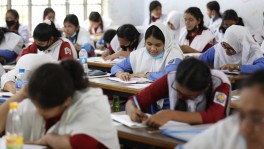Fishing in sea resumes after 65-day ban
Fishing of all species including hilsa was banned from 19 May to 23 July

Fishing in the sea resumed at midnight yesterday (23 July) after a 65-day ban drew to an end, with fishermen hoping they will be able to catch fish as per their expectations.
The fishermen were found busy preparing fishing nets and repairing trawlers at various ghats on the banks of the Karnaphuli in Chattogram. Some were carrying fishing equipment, supplies and food items in trawlers.
Marine Fisheries Department Inspector Md Manzur Alam said that in order to increase the breeding and production of fish in the sea, fishing of all species, including hilsa, had been banned from 19 May to 23 July. In compensation, fishermen were given rice at the time of the ban.
Besides, catching jatka (hilsa less than 9 inches) was prohibited from 1 November to 30 June.
As fishing was stopped for at least ten months of the year, hilsa and other varieties of fish managed to grow in the sea, a factor that will benefit the country's fisheries sector.
Rahmat Majhi, a fisherman from Banshkhali area, said, "When fishing in the sea was stopped, I had to borrow money to run my family. There are 20 fishermen in our fishing trawler and all are ready to go fishing."
Another fisherman Chandan Das said, "I have been making a living by fishing in the sea for 20 years but I always comply with rules and do not go fishing when it is banned. I hope we can make up for the loss if I net the desired quantity of fish."
Along with fishing in the sea, fishermen are hoping to catch big hilsa in the Padma and the Meghna this time. The fish in the sanctuaries of these two rivers have become quite large due to the ban on fishing for a long time.
Sumon Barua, deputy director of the Department of Marine Fisheries, said, "After a comparative analysis of past years, we expect that about six lakh tonnes of hilsa will be caught this year. Ten years ago, hilsa could be found in the rivers of 21 upazilas but at present, hilsa is found in 125-130 upazilas. At present, there are hilsa sanctuaries in the country covering an area of about 7,000 square kilometres.
According to the Department of Marine Fisheries, there are 2,98,595 registered fishermen and labourers, 30 commercial trawlers, 32,000 automatic fishing vessels and 34,000 manual vessels all over the country.
In the financial year 2007-08, the production of hilsa in the country was only 2,90,000 tonnes.
In 2018-19, it increased to 5,17,000 tonnes, which figure further rose to 5,33,000 in 2019-20.
In other words, in the last 11 years, the production of hilsa in the country has increased by about 84%.
Even three years ago, 65% of the total hilsa caught in the world was fished in Bangladesh. The figure has been 85% since last year.


 Keep updated, follow The Business Standard's Google news channel
Keep updated, follow The Business Standard's Google news channel
















